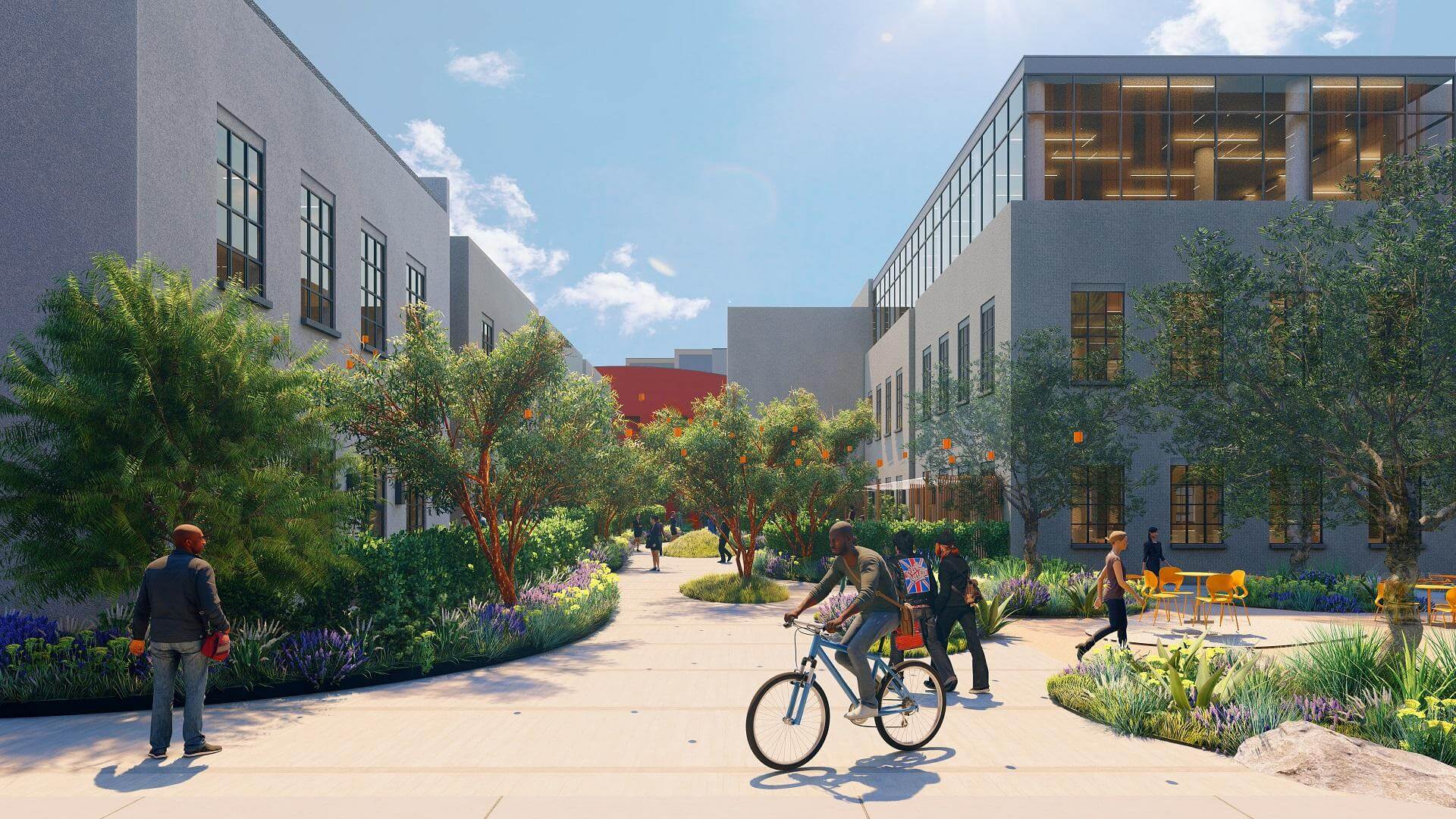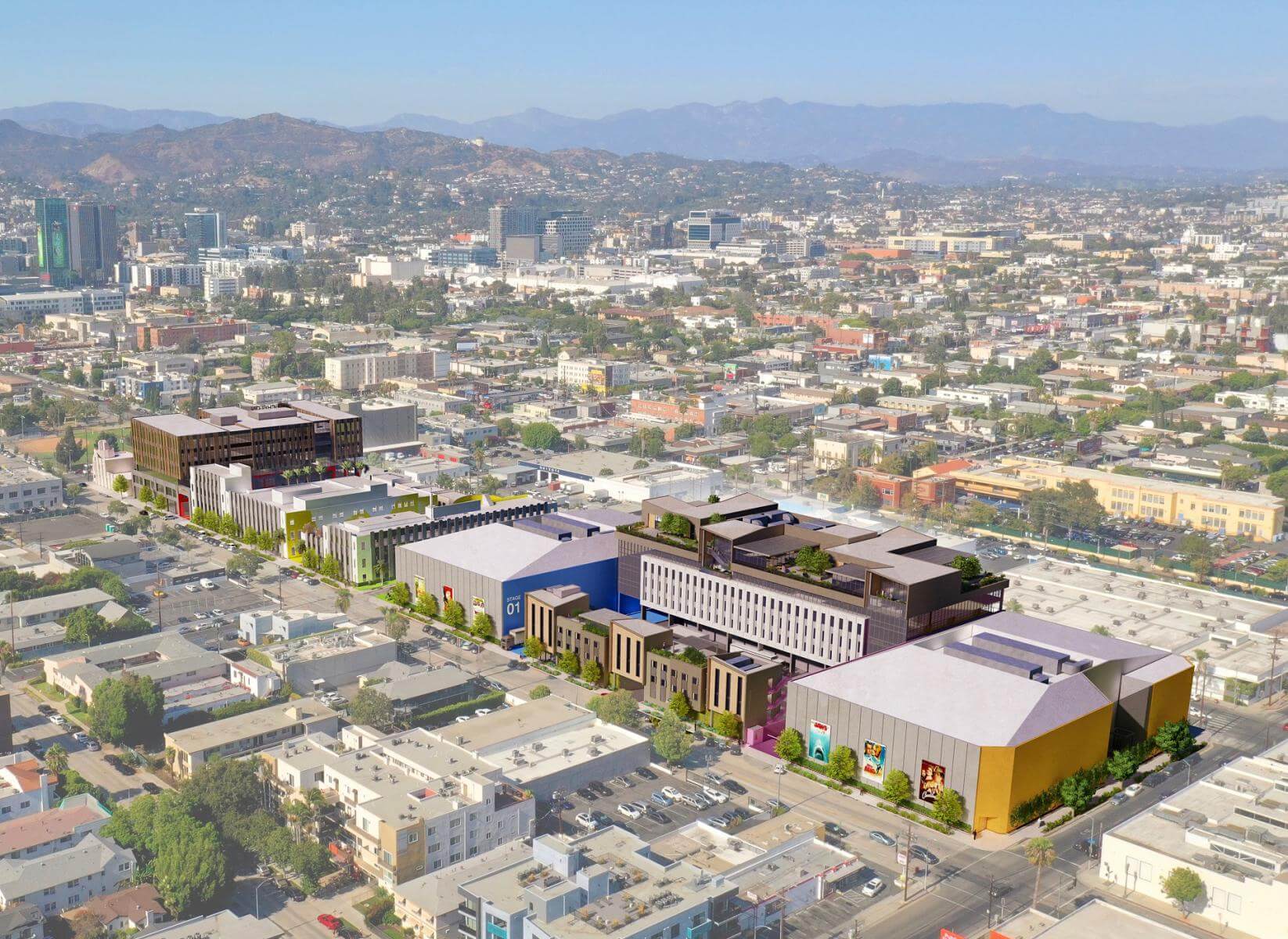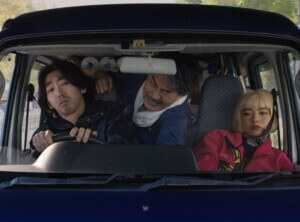The storied Hollywood site that briefly served as the studio lot for Metro-Goldwyn-Mayer forerunner Metro Pictures in the early 1920s and later the headquarters of Technicolor during its 40s- and 50s-era heyday is the latest aging Tinseltown production facility that will undergo a sweeping transformation into a roughly 620,000-square-foot urban studio complex fit for the demands of the streaming age.
As recently announced, BARDAS Investment Group and Bain Capital Real Estate will lead the redevelopment of the 6.4-acre Television Center campus. Although relatively compact by traditional studio lot standards, the complex spans two city blocks with a pair major Los Angeles arteries, Santa Monica and Cahuenga boulevards, bordering the site to the north and east, respectively. (The address of Television Center is 6311 Romaine Street). RIOS has been tapped by the development team, which acquired the site back in March for $135 million, to serve as architect and landscape architect for the project.

Although they have similar names, the redevelopment of Television Center, which gained its current moniker in the 1980s and will reemerge as the rebranded Echelon Television Center, shouldn’t be confused with CBS Television City, another L.A. production hub undergoing a RIOS-helmed redesign. Despite the similar names, the two facilities are quite different. The existing Television Center facility, located in the fast-transforming heart of Hollywood, was built out between 1930 and 1966 and as noted for its art deco design. Debuting in 1952 as the world’s first purpose-built television studio complex in the world, the much larger Television City in the Fairfax District is an exuberantly midcentury affair designed by William Pereira and Charles Luckman.
“Echelon Television Center is a site of central importance to the history and legacy of the Hollywood entertainment business,” said Bob Hale, creative director and partner at RIOS, who is also leading the neighboring Echelon Studios, a $450 million effort that will see a long-shuttered Sears outpost be transformed into the first purpose-built studio campus to rise in Hollywood in more than two decades. That project is set to break ground next year.
“Our transformative design preserves and builds on the distinctive heritage of the original Technicolor campus and allows us to reuse existing buildings for office and support buildings adaptively,” Hale added in a statement shared with AN. “Vibrant-colored streetscapes and landscapes will be utilized as flexible boundaries and invite neighbors to engage with new outdoor public spaces. As with our work on Echelon Studios, we are creating a complete studio and content campus in each location. All programmatic, functional, and amenities are composed to create an urban campus inclusive of soundstages, production support, robust outdoor space for working and shooting, and event and office space.”

Anchoring the northern end of the new Echelon Television Center complex abutting Santa Monica Boulevard will be a new mid-rise creative office building with private outdoor terraces that afford sweeping views of the Hollywood Hills and beyond. The new building will replace two crumbling structures at the site and a surface parking lot while a handful of art deco structures on the northern edge of the site will be preserved. At the southern end of the site along Willoughby Avenue, currently home to a disused parking lot, the development plan envisions four large soundstages, a basecamp, and a six-story office building that the development team said will feature “tailored creative office space, production support space, as well as private rooftop office bungalows and decks.”
“We’re optimistic that our design of Echelon Television Center will pave the way to better expectations of what a studio can be within a city,” said Bob Hale, creative director at RIOS. “Historically, studios have been built to operate like fortresses. Our intent is to provide a new model of an urban creative content campus that builds on the past, supports the creation of great content, and thoughtfully balances privacy with access and engagement for the surrounding community.”
The model mentioned by Hale, an open and accessible one that eschews the cloistered nature of studios of yore and instead gestures toward the surrounding community isn’t entirely unique to Echelon Television Center. Grimshaw’s forthcoming “vertical” production campus for East End Capital in Downtown L.A. similarly deviates from the traditional studio typology by integrating itself into the urban context.
Since coming together to form a joint venture under the Echelon brand in 2019, BARDAS and Bain Capital have invested in and have a pipeline of existing and new development projects—all focused on creative office space as well as production and studio facilities—encompassing more than 1.5 million square feet in and around L.A.
“This project represents our company’s continued focus on redeveloping infill product for the entertainment and media industries in the content capital of the world,” said David Simon, founder and managing principal of BARDAS, of the Echelon Television Center development in a statement. “The old home to Technicolor and Metro Pictures represents another great opportunity to keep ‘Hollywood in Hollywood.’”











